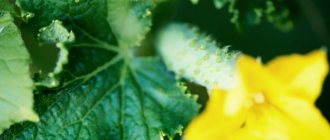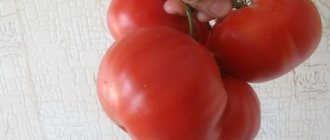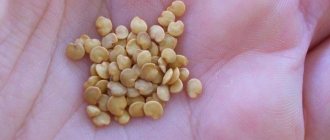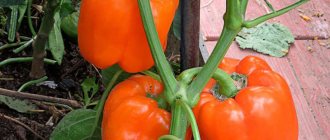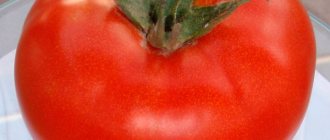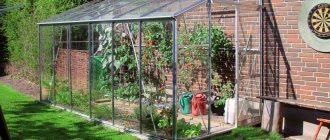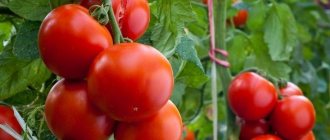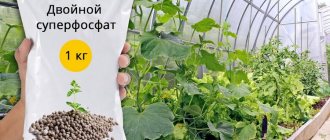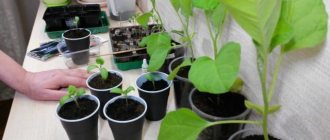The tomato variety My Love is wildly popular among residents of the southern regions. Red tomatoes are distinguished by their elongated tip, excellent taste and unsurpassed tomato aroma.
Tomato variety “My love”
tomato seeds “My love”
the fruits of the tomato variety “My Love” are juicy, aromatic, not sour
Rules for planting and care
You can plant My Love tomatoes if you purchase seedlings or grow them yourself. They do this at home in special containers filled with soil.
Sowing seeds for seedlings
Select tomato grains that are large, not stuck together, rough, but even, without black or gray spots. They are wrapped in gauze and dipped in a weak solution of manganese (1 g per half liter of water) for a quarter of an hour. Then they take it out and, also in a gauze bag, immerse it in a growth activator solution for about an hour.
At the same time, containers are prepared: they are filled with ground soil mixed with peat or sawdust. It should be light and well fluffed, so it is easier for the seeds to hatch. Before planting, the soil should be slightly moistened.
Tomato seeds are sown no later than March 15. After they are wet, they are placed in the soil at a distance of 2-4 cm from each other to a depth of 2-3 cm. Then they are covered with film and sent to a cool, bright place to germinate. The air temperature should not exceed + 20 ᵒС.
After the tomato seeds germinate, the film is removed and the lighting is turned on around the clock for a week so that the seedlings grow faster. Water the plants sparingly until the first leaf appears; usually a simple spray of water is enough. As soon as the first true leaf appears, the seedlings are watered at the root once a week, after several appear - every other day. As they grow, add soil mixture to the containers. This will strengthen and branch the tomato roots. 2 times before transferring grown plants into the ground, they are fed with fertilizers intended for seedlings
It is necessary to pick seedlings (transplant them into a separate container) 2-3 days after the first leaf appears. This will allow the development of a good root system with strong lateral shoots.
Before transplanting, tomato seedlings of the My Love variety are well watered. This will allow you to remove the plant from the container without damaging the earthen ball around the root. Root the seedlings into larger and deeper pots and cups than they were originally. Afterwards, the plants are set aside in a cool, bright place, and after a week they are transferred to a warm place.
Transplanting seedlings
Grown tomatoes are transplanted into a greenhouse after 40-50 days, into open ground after 2 months after germination. Before transferring, the seedlings are hardened: they are taken outside for 2 hours, and the air temperature should not fall below + 10 ᵒС. During the day, plants are protected from direct sunlight.
The planting area is first dug up and fertilized with peat or humus. Tomatoes of the My Love variety are planted at a distance of at least 40 cm from each other and 0.5 m between rows.
- Dig holes 1.5 times the volume of the seedling rhizome. It is approximately 20 cm deep.
- Water the seedlings in containers generously with warm water to easily separate the earthen lump.
- Afterwards, the tomatoes are rooted in the hole, sprinkled with a layer of fluffy soil.
- Then the seedlings are watered abundantly, and a low mound of earth is raked on top.
A week after planting, you can fertilize the plants with organic matter by pouring a solution of mullein or bird droppings under the roots. Organic substances are diluted with water in a ratio of 1:10.
Aftercare
After planting once a week, in the southern regions, tomatoes of the “My Love” variety are watered 2-3 times. The soil is loosened with similar regularity. After watering, the soil is mulched with sawdust or peat. Weeds are destroyed as they appear.
Tomatoes of the My Love variety are fed 3 times before fruiting begins. It is better to apply fertilizer between the rows, and not at the root. Organic fertilizing is alternated with mineral fertilizing.
My Love tomatoes are a low-growing variety, but they need to be tied up, otherwise the shoots will break off under the weight of the fruit. For gartering, a trellis is pulled, and the tops of the plant are attached to it with a rope.
How to grow seedlings
To get a good harvest, gardeners recommend planting tomatoes in seedlings. Although this takes more time and effort, it will be easier for the plant to take root in the garden plot. Especially when it comes to regions with unpredictable climatic conditions.
Seed preparation
You can purchase Family Tomato seeds at any gardening store or order by mail. On the bags, the manufacturer indicates recommendations for planting and growing.
First, inspect the seeds for defects. If individual specimens are of unusual color or shape, do not plant them. Be sure to disinfect the rest of the material.
They do this in several ways:
- lay it out in the sun for 5-7 days, for example, on a balcony or on a bench near the house;
- soak for 24 hours in a solution of potassium permanganate, for convenience, first placing the seeds in a fabric bag;
- Soak overnight in aloe juice.
Disinfection will destroy dangerous microbes on the surface of the seeds, which will subsequently ensure rapid germination and a good harvest. Afterwards it is necessary to germinate the seed material. Take a damp cotton pad, place the seeds in it and put the disc in a plastic bag or plate. In this form, the seeds are stored for 4-7 days. Germination helps the plant develop immunity to diseases and parasites.
Container and soil
Most gardeners use ready-made soil mixtures for seedlings. Firstly, they are pre-disinfected by the manufacturer and do not contain pathogens. Secondly, such soil is enriched with vitamins and minerals necessary for the plant. Purchasing land will not be difficult; on average, 10 liters costs about 150 rubles.
Plant seedlings in any clean and dry container - cardboard milk cartons, plastic cups, flower pots, and so on. Especially recently, peat pots or tablets have become popular. They are made from environmentally friendly materials, which means they are absolutely safe for both plants and humans. Such containers are affordable and easy to use
Plus, peat containers retain moisture well, which is important for a hybrid
Landing
Prepare seedlings 50 days before planting in the garden. To do this, pour the soil into a container, make grooves 2 cm deep in it. The distance between the grooves should be at least 15 cm. Place the seeds in the holes and sprinkle the soil on top. Don't forget to water the seedlings with warm water. To speed up growth, stretch the film or place glass on top.
Growing and care
The best place for growing is a bright window. However, make sure there are no drafts. As soon as half of the seeds germinate, remove the film.
Water the seedlings only with warm filtered water. For ease of watering, use a pipette or syringe. After 5 days, as soon as all the seeds hatch, organize feeding with calcium nitrate.
In the future, feed the tomatoes every 10 days. To do this, use an ash solution, liquid bird droppings, or superphosphate.
Important! An effective remedy for increasing plant immunity is Bordeaux mixture. You can buy a ready-made mixture in the store or make it yourself
Spraying from a spray bottle rids seedlings and soil of harmful microorganisms and improves the development of the root system.
Varieties for open ground
Due to their size, low-growing tomatoes are best suited for open ground, the best varieties of which we will consider below.
Mystery
Self-pollinating plants of the tomato variety Riddle are quite compact. Their medium-leaved dwarf bushes can grow up to 50 cm. The first cluster is formed above the 6th leaf and can contain up to 5 fruits, which ripen in a period of 82 to 88 days from the moment of the first shoots.
Round Riddle tomatoes are red in color and weigh up to 85 grams. Their pulp has excellent taste and is perfect for salads and canning. The dry matter in it will be from 4.6% to 5.5%, and the sugar will not be more than 4%.
The plants have good immunity to blossom end rot, and their yield per square meter will not exceed 7 kg.
Gold
The name of this variety speaks for itself. The round, almost golden tomatoes of this variety look very impressive on medium-leafed, low bushes. Tomatoes of the Golden variety are among the largest among all low-growing varieties. Their weight will not exceed 200 grams. The medium-density flesh of Zolotoy is perfect for preparing salads and eating fresh.
Distinctive features of this variety are cold resistance and high yield. In addition, the ripening of “golden” tomatoes will not take more than 100 days.
Gourmand
Its tomatoes are low-growing - only 60 cm in height. Despite the fact that Lakomka bushes are slightly spreading and leafy, one square meter can accommodate from 7 to 9 plants. The first fruit cluster on them is formed above the 9th leaf.
Gourmand tomatoes are quite round in shape. Their maturity occurs 85–100 days after emergence. In this case, the green color of unripe fruits becomes crimson as they ripen. The gourmet is distinguished by its fleshy and dense pulp. It is recommended to use it fresh.
Important! It is quite easy to distinguish a ripe tomato - it does not have a dark green spot at the stalk. Due to their resistance to blossom end rot, Lakomka plants can grow well in open ground.
A gardener can harvest from 6 to 7 kg of tomatoes from one bush
Due to their resistance to blossom end rot, Lakomka plants can grow well in open ground. A gardener can harvest from 6 to 7 kg of tomatoes from one bush.
This is interesting: Tomato Cardinal: revealing the essence
Reviews of the tomato variety My Love
★★★★★
Albina, 33 years old, hairdresser, Astrakhan. The My Love variety surprised me with an excellent harvest.
The pulp is sugary, but there is a slight sourness, which added incredible freshness to summer salads. Dense and neat fruits look good in jars. ★★★★★
Peter, 57 years old, summer resident, Moscow region. Tomatoes are not fancy at all; minimal costs were required.
I first bought seedlings and then started growing them myself. The culture has excellent taste, the fruits are stored for a long time and do not spoil. Hide
Add your review
The tomato variety My Love ripens quickly and bears healthy and tasty fruits. Excellent results can be achieved by properly caring for the crop and following all recommendations for watering, planting and harvesting fruits.
0
0
Copy link
Collection and saving
The fruits are harvested immediately after ripeness. The delay threatens rapid spoilage of the vegetable. You can remove green fruits from the bushes. Ripening takes place within a month. There is no need to be afraid of picking off ripe tomatoes: they are easily transported without damaging the shells.
Store vegetables at temperatures from +14 to +16 C in a well-ventilated area. Free air flows prevent fruit spoilage. It is necessary to regularly re-sort vegetables so that rottenness does not pass from tomato to tomato. Good fruit safety is guaranteed by freezing. The only disadvantage of this method is the change in taste.
Description of the tomato variety Earthly Love and its characteristics
Tomato Lyubov is an earthly standard determinant crop bred by Russian breeders. The variety is suitable for novice gardeners who are not yet comfortable with gardening. The crop does not require much attention, but bears fruit well and bears early fruit.
Plant characteristics
The plant is a standard type, 150 cm tall. The bush grows tall and requires shaping and tying up. The variety feels good both in greenhouse conditions and in open ground. In terms of ripening time, the Earthly Love tomato is an early variety; the first fruits can be obtained after 90 days.
The plant has many leaves. Low yield, on average up to 6 kg per bush. It is recommended to plant seedlings at the end of March. Plants love freedom, so before planting seedlings there is no need to skimp on the distance between tomatoes.
Description of fruits
Gardeners are very pleased with the fruits of the variety. Tomatoes are characterized by their versatility. Well suited for both fresh and canned use. The fruits are excellent for canning and pickling and have an attractive appearance. The ripe fruit has a bright, rich red or burgundy color. The shape is smooth and round, without ribbing or green base.
The tomato has a soft, pleasant sweetish taste. The fruits are quite large in size. The average weight is 200-300 grams. Vegetables have thin but dense skin, which protects the tomato from cracking. The tomato has good keeping quality and transportability. Gardeners often use tomatoes of this variety for commercial purposes.
Pros and cons of the variety
The variety has many advantages. This is its early ripeness and resistance to disease. Tomato has a good immune system. Tomatoes are versatile, have good flavor characteristics and are often used commercially. The plant is unpretentious to care. It is enough to water and loosen the soil in time.
Recommendations for cultivation. Earthly love grows tall and has a fragile stem. Therefore, the plant needs a garter, otherwise the trunk may break off. If the bush is grown in open ground, then you don’t have to engage in pinching. But this may result in longer ripening times.
The culture has good immunity, so if you take normal care of the plant, it will not get sick. Care consists of regular watering, loosening the soil and fertilizing.
Advantages and disadvantages
The My Love variety, like other plants, has advantages and disadvantages; these nuances must be taken into account when growing the plant.
Benefits of tomatoes My Love:
- early ripening variety;
- tolerance to drought and heat;
- excellent tolerance to temperature changes;
- pinching may not be carried out;
- simultaneous ovary and ripening of bushes;
- strong immunity to diseases;
- universal application;
- excellent taste.
Disadvantages of tomatoes My love:
- productivity is low;
- unreliable stalk;
- pickiness about fertilizing at the growth stage.
Tomato My Love F1: description and characteristics, cultivation and care of the variety, yield, photo
There is always room in the garden for early varieties of tomatoes. In the south of the country, their seeds can be sown directly into the ground, but the seedling method will allow you to obtain earlier production. Let's learn more about the early-ripening tomato hybrid called My Love F1, about its main characteristics, advantages and disadvantages over other varieties, as well as how to grow it.
History of variety selection
The variety My Love F1 is a hybrid bred by a professional breeder - Candidate of Agricultural Sciences L. A. Myazina. In 2008, it was included in the State Register of the Russian Federation and recommended for cultivation throughout the country. It can be grown in unprotected soil and in various types of shelters.
Characteristics and description of the variety
This is an early variety, the fruits of which can be harvested 85–100 days after emergence. This determinate plant forms a powerful, weakly leafy standard bush from 0.5 m in height.
In greenhouse conditions it can grow up to 1.2 m, but in open beds it is shorter. Stops growing after the appearance of the fifth inflorescence. The variety is unpretentious and resistant to temperature changes and hot weather, has good immunity and, due to its early ripening, does not have time to be affected by late blight.
Productivity
When creating favorable conditions and proper care, the yield can reach 10 kg per 1 m². Sometimes up to 5 kg of products are collected from one bush.
Pay attention to other varieties of determinate tomatoes:
Description of the fruit
Each cluster bears 5–6 one-dimensional red fruits. They have a rounded shape, slight ribbing and a characteristic spout, which may be absent in bad weather conditions.
Small fruits of moderate density and an average weight of 150–200 g have 6 seed chambers. The pulp is tender and sweetish, melts in the mouth.
Small tomatoes are great for preparing a variety of dishes and canning.
Advantages and disadvantages of the variety
- Compared to other varieties, the hybrid My Love F1 has the following advantages:
- friendly and early ripening of the crop;
- there is no need for gartering or pinching;
- ability to grow well in protected and unprotected soil;
- the fruits do not crack;
- product presentation;
- excellent taste;
- universal use of fruits;
- tomatoes are well transported;
- disease resistance;
- drought resistance.
- The disadvantages of this hybrid include the following:
- does not tolerate cold weather well and is grown in shelters in the northern regions;
- demanding of fertilizers;
- in protected ground a garter is required;
- There is no way to collect your own seed material.
Acceptable terms for cultivation
Early tomato hybrids are planted in a permanent place in protected or unprotected soil at the age of 50–55 days. On average, it will take about a week for tomato seeds to germinate. Seedlings are planted when the soil warms up to +12°C. The threat of frost must pass and the air temperature must be at least +15°C.
In central Russia, such weather is usually observed in the first ten days of June. Shelters can be planted several weeks earlier. In the southern regions, early or mid-ripening tomato seeds can be sown in the ground from the end of April.
Growing seedlings
To grow tomatoes, you can use purchased soil or make it yourself. To do this, you can mix humus, turf-leaf soil and peat in a 1:1:1 ratio and, for disinfection, calcine the mixture in the oven or pour potassium permanganate on it. Then you need to add 1.5 tbsp to the bucket of the finished soil mixture. ash, 3 tbsp. l. superphosphate, 1 tbsp. l. potassium sulfate and 1 tsp. urea.
The finished mixture is filled into containers for growing tomatoes (boxes, pots, homemade containers). Their depth should be about 10 cm, and the capacity of individual containers should be at least 0.5–1 liter. Before planting, seeds should be treated by placing them in a weak solution of potassium permanganate for 20 minutes, then rinsing with clean water and drying. If desired, they can also be sprouted.
Seeds are planted in boxes according to a 4x2 cm pattern, and 1–2 seeds are placed in separate containers. Sowing is carried out to a depth of approximately 1 cm in a moist substrate. Then the container with the crops is covered with film and transferred to a dark, warm place (+22...+25°C), monitored for soil moisture and briefly ventilated daily.
After seed germination, the film is removed and the containers are transferred to a well-lit place with a temperature of +12...+16°C for a week.
Reviews from gardeners
Igor, Taganrog
I gave the seeds to a neighbor, planted them in the OG, with pinching, and the harvest turned out to be decent. There were four brushes, each one weighing more than a kilogram.
Source: www.forumhouse.ru
Rita, Makeevka
Last year there was a crazy heat, and the tomatoes simply burned, both leaves and fruits. So we bought a net, it’s a special shading net. My seedlings were not hardened, but they did not hurt under the net. On one side 5.5 meters by 20, on the other 6.5 meters by 15. I like it.
Source: www.forumhouse.ru
Planting and growing tomatoes
Like any other variety, this variety of tomato requires special conditions in preparation for sowing seeds. At these stages, the gardener must show maximum responsibility, since the further development of the crop and the result in the form of a harvest depend on them.
Preparing and sowing seeds
Seeds of this variety must be sown at least six weeks before the day of planting in the ground. Seeds of hybrid plants, as a rule, do not need to be subjected to additional processing, disinfection and germination, unlike seeds of ordinary tomatoes.
This is explained by the fact that their preparation has already been carried out in special conditions, and they are already ready for sowing. Despite this, farmers with extensive experience recommend disinfecting seeds themselves. This procedure can be neglected only if they are granulated.
To do this, before planting, they are soaked in a strong raspberry solution of potassium permanganate. The liquid should be prepared at the rate of 1 glass of water per 1 g of dry manganese. The seeds wrapped in cotton are placed in potassium permanganate for 10 minutes and then washed with clean water.
After this procedure, they are planted in a box with soil for seedling germination. The soil in which the seeds will develop must also be disinfected. There are several methods for disinfecting the soil: someone waters the soil with a solution of the same potassium permanganate, someone heats the soil mixture in the oven, someone pours hot water over it.
The soil should be moist and compacted during sowing. Seeds must be sown in holes up to 2 cm deep, at a distance of 1.5-2 cm from each other. They are covered with soil mixture on top. Now future seedlings only need time, warmth and light.
Growing and picking seedlings
Shoots should be expected after about 7 days, in rare cases you will have to wait up to 10 days
Water the seedlings with extreme caution; the water temperature should not be lower than 22°C
The potential harvest volume is affected by the collection of seedlings. Its essence is to get rid of diseased sprouts or sprouts whose roots are not sufficiently developed.
During the transplantation process, extreme care must be taken, trying not to harm the root system and stem of the plant. Seedlings need to be planted with a lump of earth in a separate pot
After completing this process, the newly planted seedlings need to be watered with precipitated water.
Transplantation into open ground
Before planting seedlings in the ground, they must be properly prepared. To do this, in the room where the containers with seedlings are located, they begin to lower the temperature: in the daytime to +16°C, at night – about +8°C. Next, the plants are taken out into the open air, extending the time spent in these conditions to a full day.
As a rule, planting in the soil should be done 2 months after germination of the first shoots. It is necessary to carefully select the area in which tomatoes will grow, since this factor directly affects the amount of harvest.
Plants of the Irina F1 variety, like most other varieties of tomatoes, love good things and also develop quickly if they receive light and warmth, although the foliage may suffer from direct sunlight. The best place to grow tomatoes is in a well-ventilated but not cold area, facing south and protected from strong gusts of wind.
It is also necessary to be aware of what plants grew on the territory before planting Irina F1 tomatoes. Tomatoes of this variety will grow well in soil in which cucumbers or zucchini grew.
You should abandon areas where vegetables belonging to the nightshade family grew - they greatly deplete the soil, so it takes at least three years to restore it.
The soil in the selected area must be cleared of weeds, loosened, treated with a solution of copper sulfate to destroy all kinds of pests and fertilized with mineral fertilizers. After all procedures have been carried out, the ground should be dug up.
The length of tomato seedlings at the time of planting in open ground should be at least 20 cm. Before planting, seedlings are treated with insecticides to protect them from the Colorado potato beetle.
Using a checkerboard pattern, the seedlings are placed in the ground, where pre-prepared depressions are dug (no more than 4 shrubs per 1 sq. m). To prevent the shrub from wasting extra energy on growing foliage, treatment must be carried out every week, that is, the removal of emerging shoots. This will significantly increase the fertility of the crop.
How to grow
Let's look at the features of growing tomatoes My Love.
Soil requirements
Prepare the soil for planting by digging it up and loosening it. If the soil is compacted, add a little sand or peat to it. Acidic soil is mixed with dolomite flour or chalk, or lime is added to it (once every 3 years).
Sowing rules
Seeds are planted from mid-March to early April. The land is prepared and fertilized in advance.
The largest and strongest specimens are selected from the packaging. To increase germination, they are soaked in a growth stimulator. Some vegetable growers wash grains with a solution of potassium permanganate to prevent fungal diseases and destroy traces of pests. However, the hybrid planting material has already undergone the necessary processing by the manufacturer.
When the seeds hatch and the first 2 leaves appear, the plants are planted in separate containers. The strongest seedlings are selected. After 2 months (late May-early June), the seedlings are planted in open ground. Before this, they are hardened in the fresh air for better adaptation to new conditions.
When growing tomatoes in a greenhouse, sowing is carried out already in early March. Such seedlings will give a good harvest by the end of June.
Planting holes are dug 40 cm apart, the distance between rows is 70 cm. There should not be more than 3 plants per 1 m2. Fertilizers with the elements necessary for the crop are placed in the pits: potassium, nitrogen, phosphorus. The holes are made at least 20 cm deep: they should be larger than the rhizome, which will ensure high-quality picking of plants.
Care after transplant
To grow a good harvest, the crop is properly cared for throughout the summer:
- water at least once every 5 days;
- tie the bushes to a support;
- weed the beds, remove weeds and loosen the soil between the rows;
- prevent plant diseases;
- stepsons are removed;
- feed tomatoes.
Despite the fact that the hybrid tolerates temperature changes and drought well, in the first weeks after planting in open ground it needs to be covered with film.
Pinching bushes in a greenhouse ensures the fastest ripening of fruits. In open ground, plants have a stronger stem, so tying it and supporting the branches is not necessary. In ground tomatoes, garters and supports can significantly slow down and prolong the process of fruit ripening.
When cultivating a hybrid in central Russia in open ground, the seedlings are covered with film during the first month after planting. Afterwards it is removed. In the northern regions, the crop is grown only in greenhouse conditions.
The My Love tomato is quite unpretentious in watering and tolerates drought with restraint. Warm water is used for irrigation. Water once every 5 days, in the evening. A day after the soil is moistened, it is loosened and weeded.
Phosphorus and potassium supplements are very important for fruit ripening. They fertilize the bushes at every stage of growth. In the future, they switch to complex formulations. Mulching the soil increases productivity and reduces the frequency of loosening the beds.
Tomato clusters, as a rule, form on 7–9 leaf axils. To obtain the desired shape of the fruit, the stepson is left under these clusters: a second stem will form from it. Subsequent stepsons that grow to 6–8 cm are cut off in time.
Productivity
“My Love” is not characterized by high yield. With proper care, you can collect up to 4 kg of fruit from one bush, which in terms of area is 12 kg from 1 sq.m of bed.
Which regions are best to grow in?
The variety is suitable for cultivation in any region of Russia:
- In the southern regions (Astrakhan region, Kuban, Caucasus), tomatoes can be grown in open ground;
- In the middle zone, in the Urals and the Far East, this variety is cultivated under film covers;
- In the northern regions, this type of tomato is grown only in stationary greenhouses.
Growing seedlings
Every year you will have to purchase seeds in the store, since hybrids will not allow you to obtain high-quality planting material.
The soil for seedlings is prepared in the fall, saturating it with fertilizers (compost, humus, manure, mineral elements. If the soil has been wintered in the basement, it must first be cleaned of pathogens and pest larvae. A disinfectant at home will be ordinary boiling water or an oven. The latter method is not recommended because during the steaming process, the soil emits an unpleasant odor.
The sown seeds will begin to sprout by the end of the first week. After 2-3 leaves appear, the seedlings are planted in separate containers. There is no need to water it abundantly; it is better to use a sprayer to moisten the top layer of soil.
Pests and diseases
Despite the strong immunity of the variety, two diseases can still affect the plant: blossom end rot and phomosis. The remedy “Hom” and “Fitolavin” helps against bacterial spotting (phomos), and calcium nitrate helps against rot.
You should not abandon preventive measures; before planting, the planting material is heated and processed. You should also adhere to moderation in watering and regularly ventilate the greenhouse.
Some diseases and pests that also cause harm to the My Love tomato variety: Fomoz (control agent - "Lepidotsid"), Colorado potato beetle (remedy - "Prestige"), melon aphids and thrips (remedy - "Bison", "Aktellik") .
